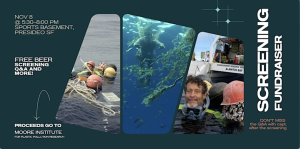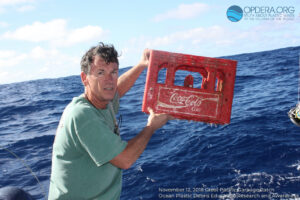
I founded the nonprofit OPDERA – Ocean Plastic Debris Education Research and Awareness because most people are not aware of the environmental catastrophe happening right before their eyes.
I WAS SHOCKED when I first read about the Great Pacific Garbage Patch 15 years ago. My further research into the subject proved inconclusive. Much that was written then was disparities; either the GPGP did not exist or a trash island you could build a house on. I did not think either of those two extremes was the truth. So I decided to sail to the Great Pacific Garbage Patch, see for myself what was there, show everyone the truth of the matter, and raise awareness of plastic waste in our oceans.
I signed up for ocean sailing lessons, became certified, then obtained a USCG Master Mariner 100 ton credential (Captains License), bought a sailboat, and started to prepare for the voyage. That took me ten years. Getting all that done while balancing a career and putting kids through college did take a while. Still, I was determined to see the GPGP and show others.
My first voyage to the Great Pacific Garbage Patch was in 2018. On that voyage, I assisted researchers in gaining information and data they could not get and needed badly.
A collaboration with NASA, NOAA, and the University of Hawaii to create a statistical model to predict the largest concentrations of debris in GPGP was developed but not proven. They needed onsite observations to support or disprove their model. I agreed to receive their statistical analysis daily during my three-week voyage, sail to target GPS locations, and provide onsite observations. When I arrived at the locations, the debris was, in fact, in more significant concentrations than other areas, thus proving their statistical model. I was surprised by a few things about that experience.
1) Why was it that NASA and NOAA, with all their resources – satellites, vessels, researchers… had not been able to do this before?
- The debris in the GPGP is floating, primarily submerged, suspended, just below the surface of the water. It is not visible from the air. Even on a boat, an observer needs to be looking low and below the water’s surface. That is where you will see a constant flow of debris passing the boat while sailing. Thus debunking naysayer myth #1, if it exists, why are there not any photos from planes or satellites? Because it cannot be seen from that vantage point, a plane or satellite.
2) That I was the first person to agree to do this was especially surprising. I had read about the GPGP 10 years prior, and no one in that time had decided to help this way? That made me sad and resilient in my cause to raise awareness. If more people knew about plastic waste in the ocean and its adverse effects, I would not have been and should not have been the first to validate the NASA-NOAA-U of H statistical modeling of debris movement and predicted areas of debris concentrations.
- More than 200 sailing vessels cross the ocean between California and Hawaii each year during the ocean yacht races, The Pacific Cup and The TransPac, alternating in odd and even years. The sailing vessels race to Hawaii and then return to the west coast – that is twice through the GPGP in a couple of months – 200 hundred transits per year. No one helped? I found out about their need to validate this statistical modeling from a representative of the U of H, Jan H., at the PacificCup finish line events in 2018. Jan approached the skipper of every vessel returning to the west coast for help. I was the only one that year to agree to help and the first to do it. Jan had attended the finish line ceremonies for the TransPac and PacCup every year for a few years to find someone who would help. That is well over 400 vessels that said they could not or would not delay or reroute their transit on the return trip to the west coast. I understand what they said no, but I do not understand why no one said yes before I did.
- Small boats are better than large vessels or ships for this type of work. Larger vessels are often moving too fast for crew or onboard citizen-scientists to see most of the trash to comprehend what they are seeing. Oversized items, yes. Small items like a flower pot, no. The vast majority of items just below the water’s surface, no. During any weather condition other than calm, no. The deck is too high. Even if the vessel was moving slower, the deck is too high for the debris concentration to be fully viewed and understood. Many large vessels have small boats that they can deploy, which does help. However, that type of setup is expensive, and those vessels are usually not equipped for extended hours – even overnight, which is necessary for good observations of what is happening in the GPGP. Any weather other than calm eliminates their chances of successful observation resulting in understanding just a small part of the GPGP.
3) The Great Pacific Garbage Patch moves around. That is why you never really get an exact location or straight answer to the question – where is it? It moves around – a lot.
- There are several large concentrations of debris in the Great Pacific Garbage Patch, not just one or two but thousands. In heavy weather – wind, rain, waves – it all disperses and gets spread out. When the weather calms, the ocean currents cause the debris to concentrate. Not in the same areas or even the same debris collection as the concentration of debris before the storm, all new concentrations of debris in new locations, all contained in the North Pacific Gyre – 1000 miles tall by 2500 miles wide – 2.5 million square miles. This type of event happens a few times each week. Yep, that often. You cannot go to the same place twice in a few days and see the same thing; it all changes. That is why a statistical model to predict the largest concentrations of debris for a given time is essential. That is why you do not get a straight answer to the question; Where is the Great Pacific Garbage Patch?
Smithsonian asked if I would collect some samples and specimens of biological organisms that I found in the Great Pacific Garbage Patch. Of course, I agreed. They provided materials for the collection and preservation of biological organisms. They provided instructions on using the tools and materials and trained me on the best way to document what I saw and found and how to preserve the specimens over a three-week ocean voyage on a small sailboat. Upon my arrival to San Francisco, I made arrangements to meet with the researchers from Smithsonian and provide them with the specimens I had collected of biological organisms living on plastic in the middle of the Pacific Ocean. I provided them with three dozen individually preserved, tagged, and documented specimens of marine life living on plastic in the middle of the ocean. Crabs, gooseneck barnacles, moss, small fish, anything I could collect, preserve, and stow in my boat. They were elated. No one had brought them that many samples before.
It took the Smithsonian researchers several weeks to understand what I had given them. When they informed me of what they found, I was again surprised. The Smithsonian researchers said that I had provided them with specimens of marine life that ‘they had never seen before.’ I could not believe that no one else had taken the time to help this way before me. The specimens they referred to are the first specimens living on plastic in the middle of the ocean of coastal species. The coastal species were on the plastic when the plastic floated further from the coast, and the different species were stuck on small plastic rafts headed out to the High Seas. They adapted to their new environment far away from their coastal home. They adapted by changing the way they lived and biologically, and maybe even genetically – but this has not been studied yet. They thrived on the open ocean to create colonies on their small raft of plastic waste from the coast. This surprised the Smithsonian researchers. They thought these particular coastal species could not live, let alone thrive on the High Seas.
All of the above are from my first voyage to the Great Pacific Garbage Patch. All of the above is documented in US Congressional testimonies. During budget hearings and Congressional hearings regarding plastic waste in the oceans.




